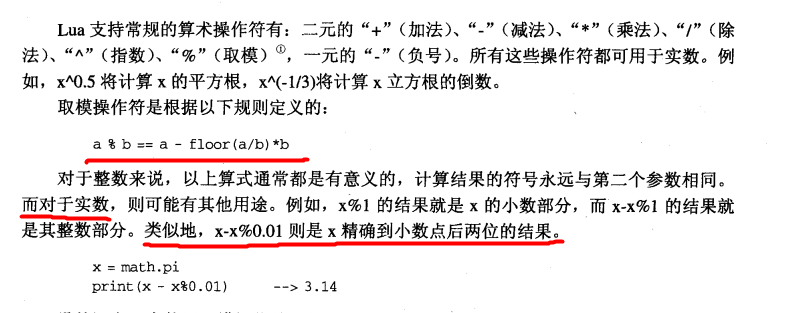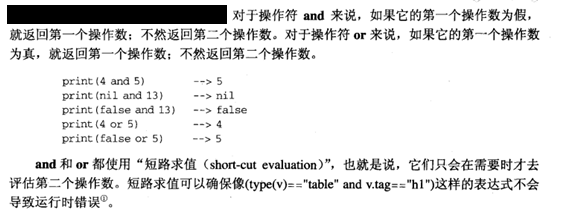CONTENTS
备注:
1 本笔记只记录了LUA的一小部分内容,对于LUA的描述并不全面,以后随用随增加吧。
2 本笔记参考《Lua程序设计 第二版》,截图和代码属于原作者所有。
3 作者初学LUA,经验和能力有限,笔记可能有错误,还请各位路过的大牛们给予指点。
算术操作符:
Lua没有整数和浮点数的区别,因此关于取模运算符如下图:

关系操作符:
nil只与其自身相等。

逻辑操作符:

多重赋值语句:

v1,v2 = 10,20;
print("v1:" .. v1 .. " v2:" .. v2); -->输出v1:10 v2:20
v1,v2 = v2,v1;
print("v1:" .. v1 .. " v2:" .. v2); -->输出v1:20 v2:10
局部变量与语句块:
Local v = 10; --显式界定一个语句块: do local v = 100; print(v); -->输出100 end print(v); -->>输出nil
if结构:
v1 = 0;
if v1 < 10 then
print("v1 < 10");
end
if v1 < 10 then
print("v1 < 10");
else
print("v1 >= 10");
end
if v1 < 10 then
print("v1 < 10");
elseif(v1 < 20) then
print("v1 < 20");
else
print("v1 >= 20");
end
while语句:
local num = 0; while num < 4 do print(num); num = num + 1; end
repeat..until类似于do..while:
local num = 5; repeat print(num); num = num - 1; until num == 0
数字型for语句:

不要在循环过程中修改控制变量的值!

泛型for语句:
这里先简单的笔记下最常用的:
tb = {"A","B","C",name="Hello",[10]="D",["age"] = 20};
for i,v in ipairs(tb) do
print(i,v);
end
print("====");
for i,v in pairs(tb) do
print(i,v);
end
输出:
1 A 2 B 3 C ==== 1 A 2 B 3 C 10 D
关于pairs 和 ipairs:
Ipairs:【 http://manual.luaer.cn/pdf-ipairs.html 】
Returns three values: an iterator function, the table t, and 0, so that the construction for i,v in ipairs(t) do body end will iterate over the pairs (1,t[1]), (2,t[2]), ···, up to the first integer key absent from the table.
Pairs:【 http://manual.luaer.cn/pdf-pairs.html 】
Returns three values: the next function, the table t, and nil, so that the construction for k,v in pairs(t) do body end will iterate over all key–value pairs of table t.
测试用Return语句:

发表评论